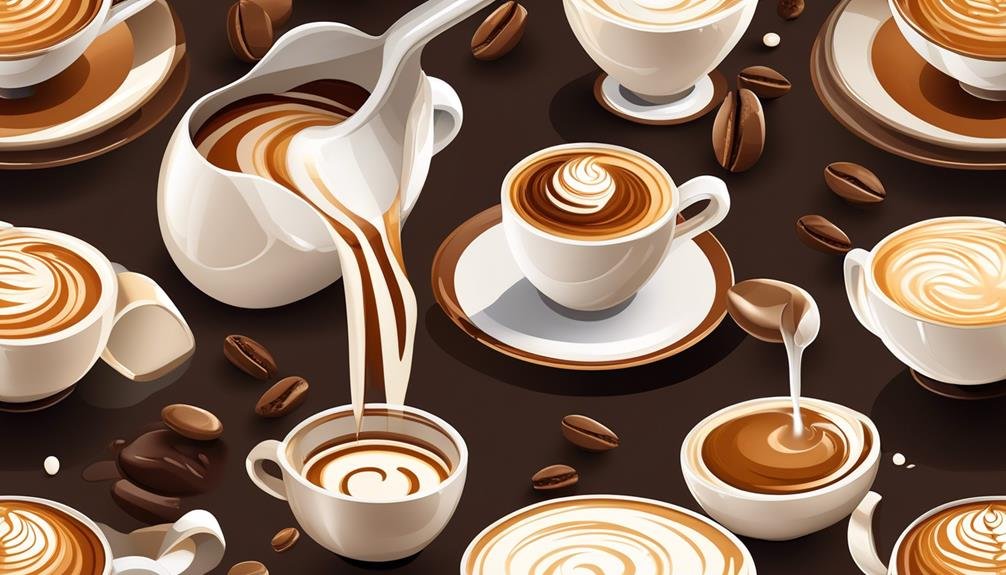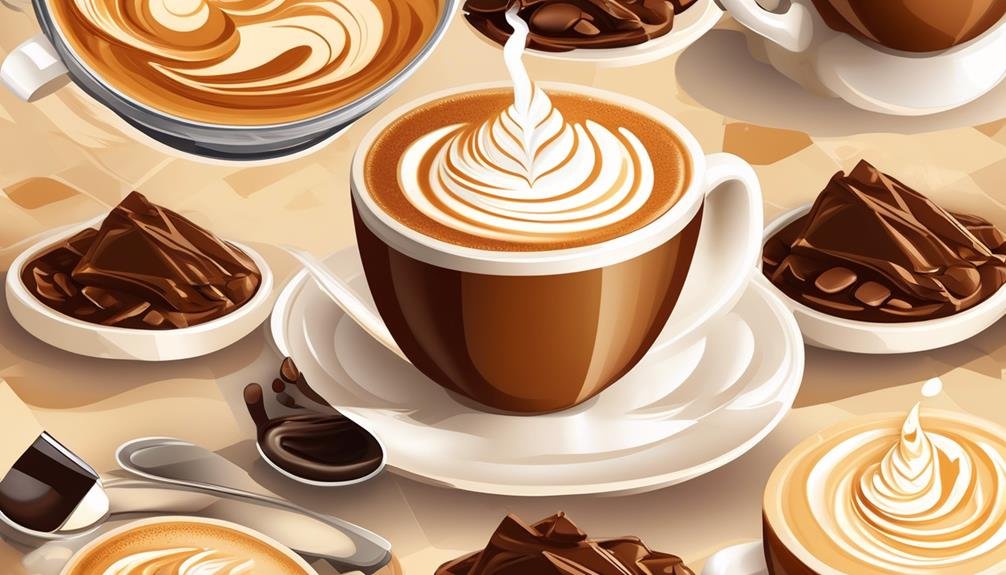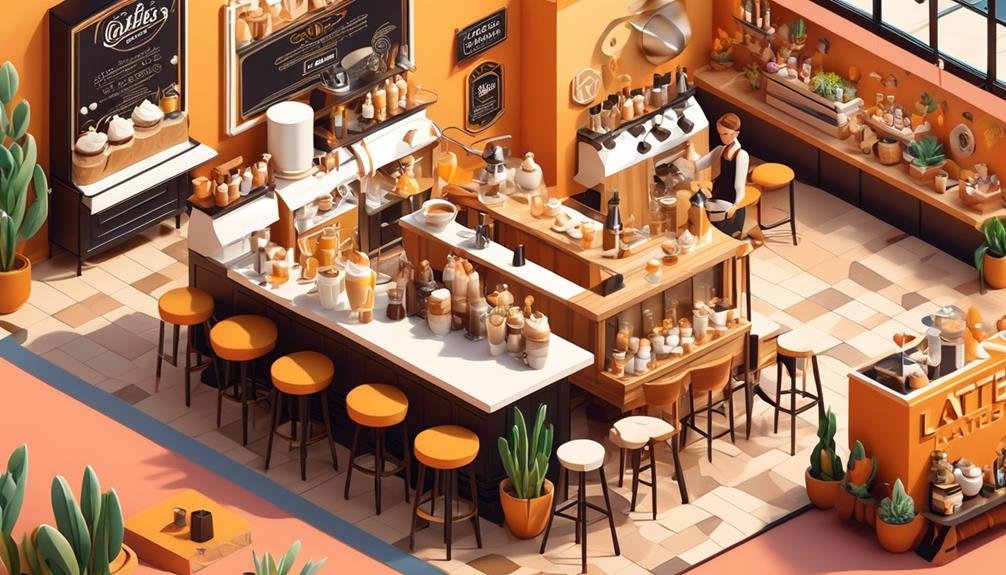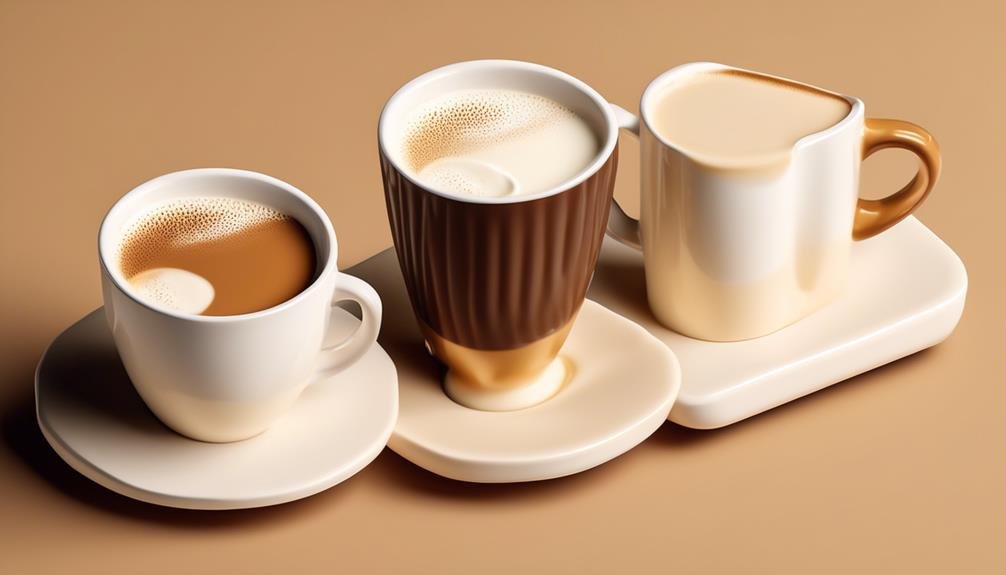Craving a caffeinated concoction but caught in a conundrum between a cappuccino and latte? Fear not, for there is a distinct difference between these two beloved beverages.
With equal parts espresso, steamed milk, and foam, a cappuccino boasts a layered appearance and a bolder espresso flavor.
On the other hand, a latte, with more steamed milk and a delicate layer of foam, offers a smoother texture and a milder espresso taste.
But that's just the tip of the espresso iceberg. So, if you're in need of some coffee clarity, buckle up and prepare to explore the nuances that set these two drinks apart.
Key Takeaways
- Cappuccinos have a higher espresso-to-milk ratio, resulting in a stronger coffee taste, while lattes have a higher milk-to-espresso ratio, offering a milder and creamier taste.
- Cappuccinos have a layer of foam on top, while lattes have a layer of frothed milk on top.
- Cappuccinos have a stronger, more pronounced coffee flavor, while lattes are generally milder and sweeter.
- Lattes can be customized with various syrups and spice blends, allowing for a wide range of flavors, while cappuccinos are more traditional in their taste profile.
Latte Origins
The origin of the latte can be traced back to Italy, where the addition of milk to coffee was a common practice, resulting in a smoother and milder flavor profile. The latte, also known as 'caffe latte' in Italian, is made by combining espresso with steamed milk. The term 'latte' itself is derived from the Italian word for milk, highlighting the key ingredient in this beloved beverage.
In Italian coffee culture, the addition of milk to coffee was a way to create a more balanced and enjoyable drink. The milk helps to temper the intensity of the espresso, resulting in a smoother and less bitter flavor. This combination of espresso and milk creates a harmonious blend, where the richness of the coffee is complemented by the creaminess of the milk.
The latte differs from other coffee drinks, such as the cappuccino, in its ratio of milk to espresso. While a cappuccino typically has equal parts espresso, steamed milk, and foam, the latte has a higher proportion of milk, resulting in a creamier and less frothy texture. The milk in a latte is steamed, which helps to create a velvety texture and incorporate air to produce a layer of foam on top.
Cappuccino Ingredients
As we shift our focus to the cappuccino, let's explore its distinct ingredients that contribute to its unique flavor and texture.
The cappuccino starts with one or two shots of espresso, which forms the base of this beloved coffee drink. But what sets it apart are the specific additions that give it its signature taste. Here are the key ingredients that make up a cappuccino:
- Espresso: The foundation of a cappuccino, espresso is a concentrated form of coffee that's brewed by forcing hot water through finely ground coffee beans. It provides the rich and robust flavor that's characteristic of this drink.
- Steamed Milk: Next, a layer of steamed milk is added to the espresso. The steaming process creates a velvety and creamy texture, enhancing the overall mouthfeel of the cappuccino.
- Foam: To top it off, a thick and airy layer of foam is added. This foam is created by introducing air into the steamed milk, giving the cappuccino its distinctive frothy appearance. The foam adds a delicate touch and contributes to the overall balance of flavors.
The perfect cappuccino achieves a harmonious 1-to-1 ratio of liquid to foam, allowing the espresso to shine through while still providing a smooth and creamy experience. With its stronger espresso flavor and balanced combination of steamed milk and foam, the cappuccino offers a delightful and satisfying coffee experience.
Latte Ingredients

To create a latte, you'll need a combination of one or two shots of espresso, steamed milk, and a delicate layer of frothed milk on top.
The key ingredients of a latte are espresso and steamed milk. The espresso shots provide a strong and concentrated flavor, while the steamed milk adds a smooth and creamy texture.
The milk is steamed using a milk frother, which heats the milk and creates small bubbles, giving it a velvety consistency. The frothed milk is then carefully poured over the espresso and steamed milk to create a layer of milk foam on top. This layer of foam not only adds visual appeal but also contributes to the overall taste and texture of the latte.
Unlike a cappuccino, where equal parts of espresso, steamed milk, and foam are used, the proportion of steamed milk is higher in a latte, resulting in a more subtle espresso taste. Additionally, lattes can be customized with flavored syrups like vanilla or hazelnut for added variety.
Cappuccino Preparation
For a perfect cappuccino, start with one or two shots of espresso as the foundation. The preparation of a cappuccino involves several steps to achieve its distinct taste and texture. Here's how you can make a delicious cappuccino:
- Add a layer of steamed milk: After extracting the espresso shots, pour steamed milk over the espresso. The steamed milk should be heated to a temperature of around 150°F (65°C). The milk adds a creamy and smooth texture to the cappuccino.
- Create a thick and airy layer of foam: To achieve the signature velvety texture of a cappuccino, you need to create a layer of foam. This is done by frothing the milk using a steam wand or a milk frother. The foam should be thick and airy, with small bubbles.
- Achieve the perfect ratio of liquid to foam: A well-balanced cappuccino has a 1-to-1 ratio of liquid to foam. This means that the amount of espresso and steamed milk should be equal to the amount of foam. This ratio ensures that the espresso flavor is pronounced while still providing a creamy texture.
Latte Preparation

To move from the cappuccino preparation to the latte preparation, we shift our focus to creating a velvety smooth latte with a customizable flavor profile.
The latte is a popular Italian coffee beverage that combines the rich flavor of two shots of espresso with hot steamed milk. To prepare a latte, start by pulling one or two shots of espresso using finely ground coffee beans and an espresso machine.
While the espresso is brewing, steam the milk to create a creamy and smooth texture. Once the espresso is ready, pour it into a cup, leaving room for the milk. Then, carefully pour the steamed milk into the cup, holding back the foam with a spoon to create a distinct layer.
To finish, add a thin layer of frothed milk on top, which adds a touch of creaminess and enhances the latte's visual appeal. If desired, you can customize your latte by adding flavored syrups, such as vanilla or hazelnut, to create your own unique taste.
It's important to note that a latte is different from a flat white, which is made with a double shot of espresso and less milk. Both are delicious espresso drinks, but the latte offers a creamier and more indulgent experience.
Differences in Taste Profiles
What distinguishes the taste profiles of cappuccinos and lattes? The difference lies in the boldness of the coffee flavor and the texture of the drinks. Here are the key points to understand:
- Cappuccinos have a strong, pronounced coffee flavor that's favored by veteran coffee lovers. The espresso shots in a cappuccino provide a robust taste that stands out.
- Lattes, on the other hand, are milder and generally sweeter. They cater to those who prefer a more subtle coffee flavor. The espresso shots in a latte are balanced with a larger amount of milk, resulting in a smoother taste.
- Cappuccinos have a foamier, fluffier texture due to the frothed milk. The milk is steamed and aerated, creating a layer of creamy foam on top of the espresso. This traditional cappuccino texture adds to the overall experience.
- Lattes, on the contrary, have a more traditional coffee-like texture. The milk in a latte is steamed to create a silky and smooth texture that blends seamlessly with the espresso.
These differences in taste profiles make cappuccinos and lattes distinct choices for coffee enthusiasts. Whether you prefer the boldness of a cappuccino or the milder, smoother taste of a latte, the choice ultimately comes down to your personal flavor preferences.
Modern Variations of Lattes

Now let's explore the exciting world of modern variations of lattes, where the traditional espresso and milk combination is transformed into a diverse array of innovative and flavorful options. Lattes have evolved beyond their basic form and can now be customized with various syrups and spice blends, offering flavors like mocha, vanilla, peppermint, cinnamon, and hazelnut. These flavored lattes provide a delightful twist to the classic drink, allowing individuals to indulge in their preferred tastes.
In addition to the traditional coffee-based lattes, modern variations have also introduced alternatives to espresso. Matcha, mate, and tea can now be used as the base for lattes, catering to those who prefer different types of beverages. These alternatives impart their unique flavors and characteristics, adding a refreshing twist to the traditional latte experience.
Another popular modern variation is the chai latte. Made with black tea and a blend of warm spices, such as cinnamon, cardamom, and ginger, the chai latte has gained popularity as a flavorful alternative to the traditional latte. The combination of the bold tea flavor and the aromatic spices creates a rich and comforting drink that appeals to many.
How to Choose Between Cappuccinos and Lattes
When deciding between cappuccinos and lattes, consider the strength of the espresso flavor and the desired milk-to-foam ratio in order to choose the perfect drink for your taste preferences. Here are some factors to consider:
- Espresso Flavor: If you prefer a stronger coffee taste, opt for a cappuccino. With its higher ratio of espresso to steamed milk, cappuccino delivers a more pronounced coffee flavor. On the other hand, if you prefer a milder, creamier taste, a latte is the way to go. Its higher ratio of steamed milk to espresso creates a smoother and less intense coffee experience.
- Milk-to-Foam Ratio: Cappuccinos and lattes differ in their milk-to-foam ratios. Cappuccinos have a well-defined layer of foamed milk on top, which adds a velvety texture to the drink. Lattes, on the other hand, have a thin layer of foam on top of the steamed milk. If you enjoy a more textured and layered drink, go for a cappuccino. If you prefer a simpler and smoother drink, choose a latte.
- Personal Preferences: Ultimately, the choice between cappuccino and latte comes down to personal taste preferences. If you enjoy a stronger coffee kick and a more pronounced espresso flavor, cappuccino is the way to go. If you prefer a milder and creamier experience with a higher milk-to-espresso ratio, a latte is the perfect choice. Don't be afraid to experiment and try both to discover your preference.
Frequently Asked Questions
Is a Cappuccino Stronger Than a Latte?
Yes, a cappuccino is stronger than a latte. It has a higher concentration of espresso due to less milk and more foam. This results in a bolder flavor profile and a more intense caffeine kick.
Which Is Healthier Latte or Cappuccino?
A latte and cappuccino can both be made healthier by choosing non-fat milk or alternative milks like almond or oat milk. The choice between the two depends on your personal definition of healthy and taste preferences.
What Is the Froth Difference Between a Latte and a Cappuccino?
The froth difference between a latte and a cappuccino lies in the thickness and texture. In a cappuccino, the foam is thicker and airy, while in a latte, it is thinner.
What Has More Caffeine Cappuccino or Latte?
A cappuccino generally has more caffeine than a latte. The higher proportion of espresso to milk and foam in a cappuccino contributes to its stronger caffeine content, making it the more caffeinated choice.
Conclusion
In conclusion, the key differences between a cappuccino and latte lie in their ingredients, preparation, and taste profiles.
While a cappuccino consists of equal parts espresso, steamed milk, and foam, a latte has more steamed milk and a light layer of foam.
This results in a stronger espresso flavor and layered appearance for the cappuccino, while the latte offers a smoother texture and more subtle espresso taste.
Ultimately, the choice between the two comes down to personal preference for taste and texture.




